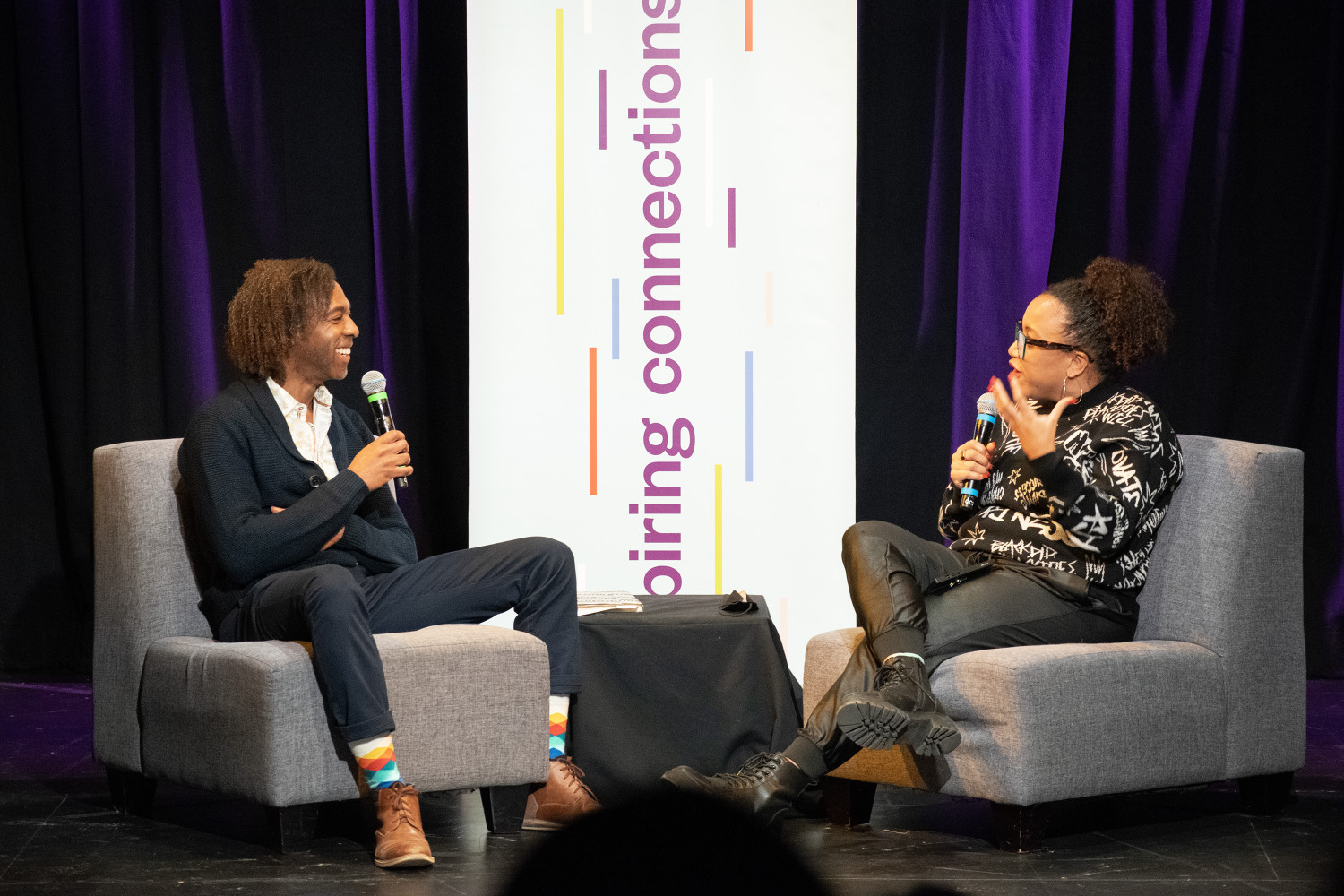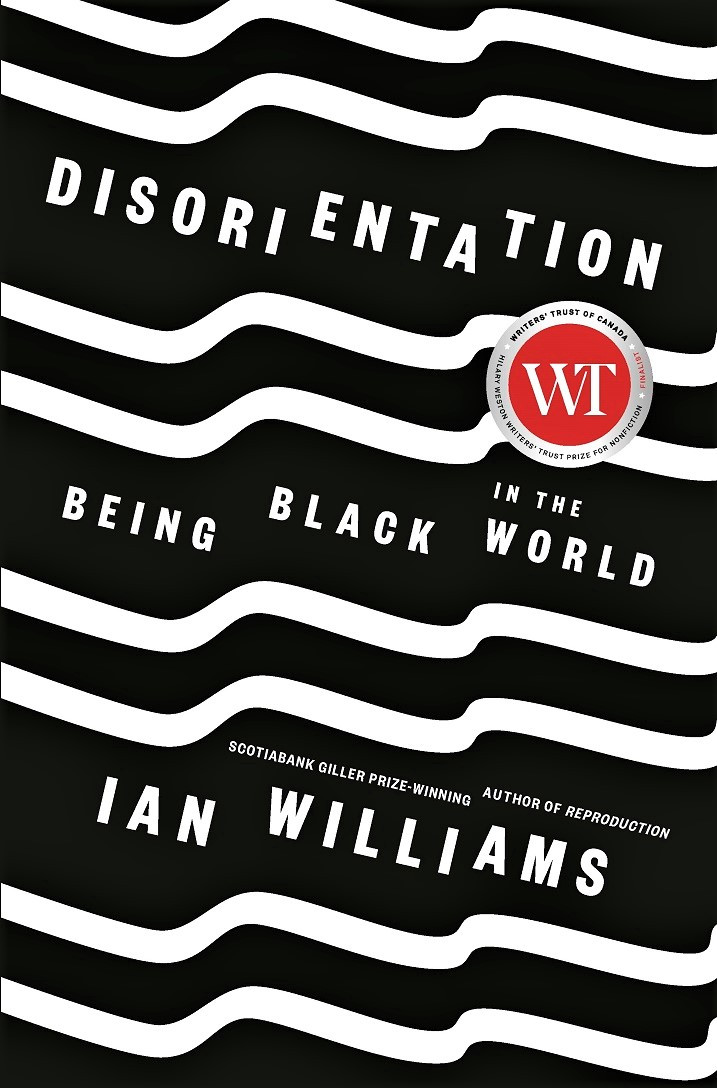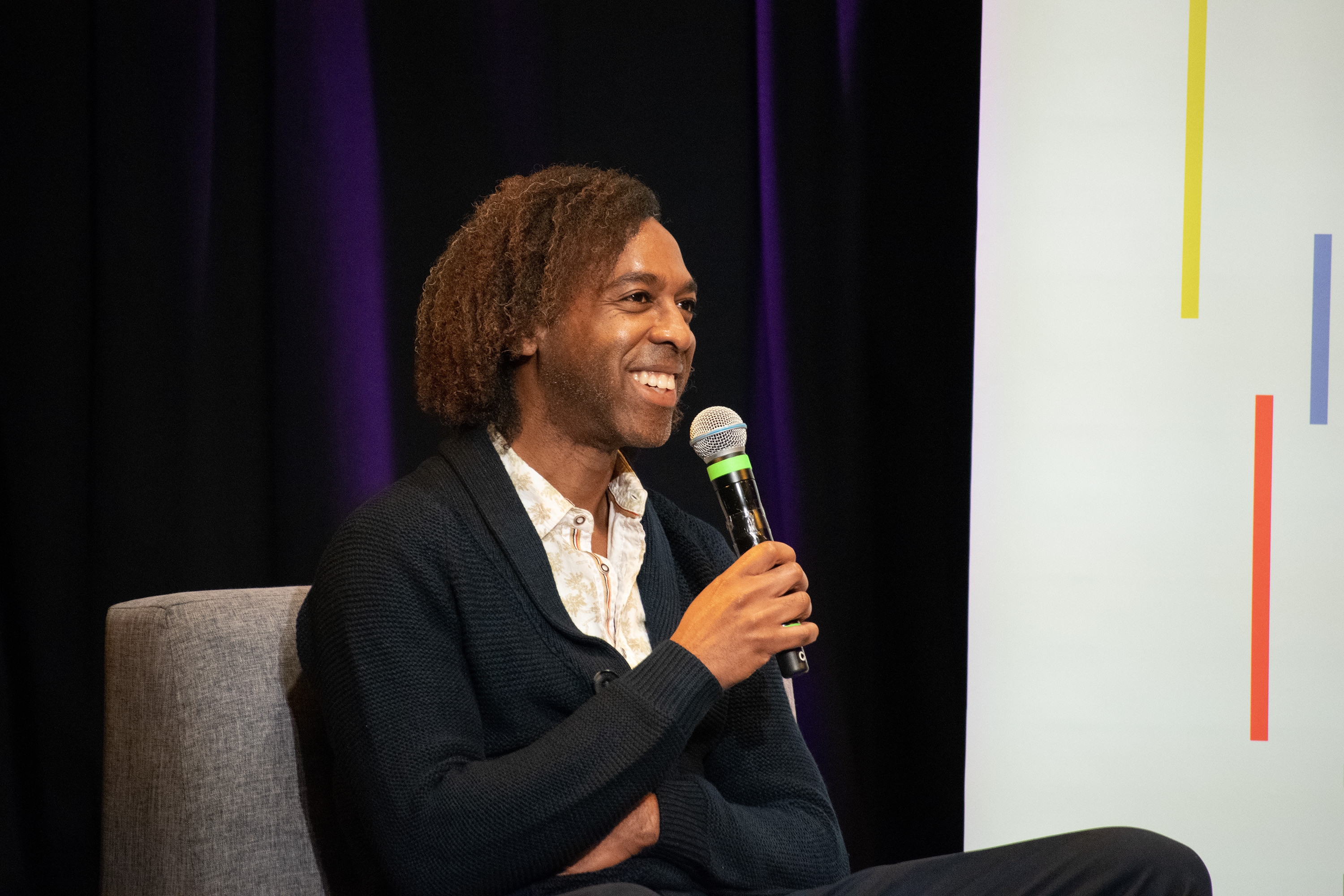
Award winning Brampton author and poet Ian Williams discusses Disorientation: Being Black in the World
Ian Williams is a tenured English professor whose use of the language does not put people on guard, but clearly defines him as a man of words.
While packing his belongings when departing British Columbia years ago a mover mistook him for a labourer.
The interaction has stayed with him. In front of a full house inside the Cyril Clark Lecture Theatre two weeks ago, he recalled the encounter and a discussion Williams had about it with his partner.
“Ten years later, we were in Vancouver, putting on our sneakers to go running, and I ask her a question I should have asked her when we met in Indiana: Have you ever had a Black prof?” Williams shared with the audience, reading from his collection of essays, titled Disorientation: Being Black in the World.
“She scrolled through her memory. ‘No,’ she said. ‘What about a Black teacher?’ ‘Definitely not,’ she said. She grew up in a small midwestern town that was 94 percent white, a census number that she said was an underrepresentation of whiteness. ‘Have you ever had a teacher or professor who was not white?’ ‘Nope.’”

(Penguin Random House Canada)
Disorientation was selected by the Boston Globe as a 2021 best book of the year and it was a finalist for the Canadian Writer’s Trust award for non-fiction.
Williams’ debut novel, Reproduction, about the often unexpected, sometimes comical and even more often unconventional ways by which family bonds are formed, won the 2019 Scotiabank Giller Prize, Canada’s highest literary award.
His books of poetry and other works have been recognized with various awards and widespread critical acclaim.
An associate professor of English at the University of Toronto, Williams was born in Trinidad and grew up in Peel, attending Brampton’s Sir John A. MacDonald Senior Public School and Mayfield Secondary School. He completed his Ph.D. in English at the University of Toronto, then moved onto teaching poetry in the School of Creative Writing at the University of British Columbia for several years before returning to U of T as a professor.
His path has been marred by alienation. When the mover assumed Williams did work that doesn't require years of education it was just another example of how the only Black person in a room often feels, because of those around them.
In 2010 he had his first book of poetry published, You Know Who You Are, which was shortlisted for the ReLit Award. Not Anyone's Anything was then published in 2011 (a collection of three fictional stories), then a second poetry collection, Personals, received widespread attention in 2012.
By 2019 his debut novel, Reproduction, which captures the complexities of history, time and place and the ways people are united, and separated, through kinship bonds, marked the arrival of another Canadian literary star.
Word Problems the following year, using math and grammar lessons to shape poems around life’s more difficult problems such as "racial inequality, pernicious depression, and troubled relationships", showed readers the range and flexibility of his abilities.
His most recent work, Disorientation, was published in 2021, the same year Williams was inducted into the Brampton Arts Walk of Fame. The book of essays, which should appeal to readers who believe "civil conversation on even the most charged subjects is possible", considers the impact of racially and culturally tinged encounters on ordinary people from different backgrounds.
"Inspired by the essays of James Baldwin, in which the personal becomes the gateway to larger ideas", the book explores the unmistakable moment when a child realizes they are Black; the ten characteristics of institutional whiteness; how friendship forms a bulwark against being a target of racism; the meaning and uses of a Black person's smile; and blame culture – or how we are all now challenged to make meaningful change when no one feels responsible for the systemic structures of the past.
Williams discussed Disorientation at the Cyril Clark Theatre event, hosted by the Brampton Library on February 8, when he spoke alongside Jael Richardson, executive director of the Festival of Literary Diversity (FOLD), and dove into the book’s subject matter, issues that play out every moment in one of the most racially and culturally complex cities in Canada.
He called Disorientation a “midlife reckoning.” It was 2020 when he first started writing, COVID had just entered the collective consciousness, wildfires ravaged the coast of California colouring the sky over Vancouver, and racial justice movements stretched around the globe. He found himself looking inward. He wanted to craft a nonfiction work, but felt a writer's block that would ultimately form the essays of Disorientation – not the book he had set out to write telling a singular narrative, but a collection of smaller works exploring what being Black in the world means for him.
“It’s not that I find race in everything, but race finds me. Some racial information comes my way every day. If I go a day without seeing a Black person I question the city, my circle, my engagement with the world. I eat a piece of chocolate and remember a Youtube video where a Chinese woman asks a Black man, ‘When you eat chocolate, how do you know when to stop?’ I see a white man with a sharp fade, when did that become stylish for them? If someone (white) on the next tennis court only addresses my partner but not me for the hour I get thrown off a little. I’m cleaning my condo for a viewing and wonder if the potential buyers will question the number of books by Black people on my shelves. Will they find one of my curled hairs on the tile and choose not to buy my condo?”
— Ian WIlliams, Disorientation
Williams started the conversation with excerpts he called “micro-readings” discussing what it means to have a world coded with racial information. He explained that while people who are not Black have the luxury of not “seeing race,” for those who are, racial coding is an inescapable reality which influences day-to-day life, from individual social interactions, to careful decisions at work and life in the broader community as a whole.
Williams said Black community members have to constantly keep track of these cues which leads to social exhaustion, because not doing so risks “social death.” This would come up again and again, whether it was his partner unable to think of a teacher she had who was not white, or the mover who assumed Williams did the same type of work – a job that does not require years of education. Returning to the imagery of being “the only”, which those who have always existed in the dominant group simply can not understand, he said standing alongside them can be branded an achievement, a kind of exceptionalism, but Williams said it is often felt as loneliness.
Even if someone has only ever known one language, say English, those who are white often confuse race as an attribute or characteristic, associating a person who does not look like them as somehow unable to understand the language the way they do, even if the “other” individual has only ever known the same language.
Williams explores education and the way it shapes young people, an issue that has created widespread controversy across the Peel District School Board, which is in the midst of its own reckoning, after decades of systemic racism finally being confronted within an organization whose educators are overwhelmingly white and whose students overwhelmingly are not.
“Consider the implications of a thoroughly white education. Consider the perspectives that you’ve never had pass through your life.”

Williams was born in Trinidad and grew up in Peel, attending Brampton’s Sir John A. MacDonald Senior Public School and Mayfield Secondary School.
(Alexis Wright/The Pointer)
The essay he found in Disorientation most challenging, he said, was “The Ten Bullets of Whiteness.” It explores the differences between whiteness and blackness. Where whiteness is day-to-day life and, in many contexts, does not even exist, blackness is inherently charged in many societies, and in the perspective of some white people it can only be considered outside their ‘normal’ existence.
The Catholic Church’s chronic, historic abomination around priests who sexually assault children is almost never considered a problem created by white men, whiteness or a white, European social organizing principle, but if the same problems plagued a Black institution of worship, whites would view it entirely as an issue of race. This is how whiteness escapes racial categorization, it is simply the default way of the world, where they are the majority; and where white ways of thinking have been used, historically, to justify the spread of their interests where they are not the majority.
Speaking in a streamed conversation hosted by the Art Gallery of Ontario, Williams previously described the whiteness of colonialism, and the way European imperialists for centuries used the influence of their way of life.
“They hold up an ideal life, right, as a kind of model to aspire to… this is how whiteness replicates itself in its colonial subjects. To get that life you ought to pattern yourself according to that whiteness, you need to speak that way, and act that way and dress that way, and have all the affectations of whiteness, under the illusory promise that at some point you will attain that life. But that life is never yours to have, right. It’s not even necessarily a good life. That life is actually quite hollow, and predicated on somebody else’s suffering in order to have self definition.” (In a way, this is why certain characteristics associated with whiteness continue to pose problems, because instead of being seen as something to question, they are either celebrated, or excused as part of what defines normal, everyday life for “most” people.)
Williams has spoken about one particularly glaring problem with the reality of this “life”: that when white people do harm to others, it too gets normalized, a consequence of behaviour that is simply human, the default. Instead of looking at themselves in the mirror and directly into the eyes of those they have harmed, whiteness becomes a form of justification — even horrific acts are part of what being human, unfortunately, is all about. So get over it everyone.
But when a Black person does harm to a white person, suddenly race, and all the associated, unique characteristics stereotypically ascribed to all others who look like the wrongdoer, is the reason their harm is entirely different and so much more dangerous. It is not human.
Williams suggests these contradictions are now changing how whiteness is understood, or, more importantly, whiteness is being understood, finally, as a unique set of accompanying characteristics, not simply as the default.
“There is a difference between whiteness and white people yet I can’t resolve the differences as neatly as I would like. After all, white people uphold whiteness and transfer its crimes to institutions, processes, bureaucracy, to keep their hands clean in the way some wealthy people launder their assets. The institution of whiteness is better protected than white people themselves. The people are disposable in the ongoing machinery of this system. The power of institutionalized whiteness extends beyond the span of any individual life. Do white people separate blackness from Black people? Perhaps white people should bear more responsibility for whiteness. I’m conflicted at the moment how Black people carry the stereotypes of Blackness, even though we don’t contribute to them while white people can repudiate the history of whiteness as separate from themselves.”
— Ian Williams, Disorientation
With whiteness not being something often talked about to white people, which Williams finds an especially difficult subject to tackle while being both “respectful and controlled” without attack or favoritism, to say that someone is white, Williams explained, is neither an insult or praise.
“I think often when we identify whiteness to white folks, they get a little bit, ‘When did this become a racial conversation?’ In the way Black people are meant to sort of understand that we’re Black and be reminded of it all the time. When a racialized person says, ‘That white person over there’ or ‘this white person’ or ‘that white person,’ it’s taking the same liberty that’s been taken on us for a long time and really it’s reminding them that white does not get neutrality while everything else gets charged.”
While many of Disorientation’s essays use a traditional form, others do not. One showcases a WhatsApp conversation between Williams and a friend in the United States, while they attempted to trace their ancestry. An excerpt was read with Richardson, who voiced Williams’ American friend who tried to make sense of his ever changing adopted country of origin.
Williams explained the purpose of the exchange’s inclusion in the book is to contemplate “longevity” and how it’s used as a non-spoken cultural value in North America – the longer you have been in a place the more claim you have to the place (of course, this conveniently excludes Indigenous populations). So there is an entitlement around the establishment of one's lineage.
For Black community members specifically, Williams explained there is a permanent disconnect due to the irrefutable separation from Africa. He described his own family tree tracing back only to his grandmother.
“Every once in a while, every ten days or so it hits me. Just how impossible that theft is to address. To take someone's entire background or history away from them and leave the population permanently alienated.”
Discussing his work, Williams turned to the essay titled, “More than half of Americans can’t swim.”
“We don’t need to be the folks we see praised and lauded on TV to do important racial work, and that said, we shouldn’t use our own temperaments to prevent us from doing this work – the reverse is true, where a loud person should attend more to listening and a shy person shouldn’t let their shyness prevent them from speaking up in the face of conflict.”
Brampton Library has 20 holdable copies of Disorientation: Being Black in the World, which residents can access with their membership card.
Email: [email protected]
Twitter: @JessicaRDurling
COVID-19 is impacting all Canadians. At a time when vital public information is needed by everyone, The Pointer has taken down our paywall on all stories relating to the pandemic and those of public interest to ensure every resident of Brampton and Mississauga has access to the facts. For those who are able, we encourage you to consider a subscription. This will help us report on important public interest issues the community needs to know about now more than ever. You can register for a 30-day free trial HERE. Thereafter, The Pointer will charge $10 a month and you can cancel any time right on the website. Thank you
Submit a correction about this story


